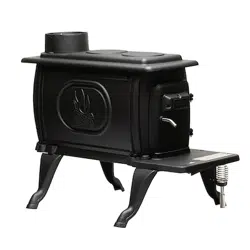Loading ...
Loading ...
Loading ...

-13-
CREOSOTE - FORMATION AND NEED FOR REMOVAL
When wood is burned slowly, it produces tar and other organic vapors, which combine with expelled moisture
to form creosote. The creosote vapors condense in the relatively cool chimney ue of a slow-burning re. As a
result, creosote residue accumulates on the ue lining. When ignited, this creosote makes an extremely hot re.
The chimney connector and chimney should be inspected at least once every two months during the heating
season to determine if a creosote build-up has occurred. If creosote has accumulated (3mm or more), it should be
removed to reduce the risk of a chimney re. We strongly recommend that a magnetic thermometer be installed
on the smoke exhaust pipe, approximately 18” above the stove. This thermometer will indicate the temperature
of the gas exhaust fumes within the smoke exhaust system. The ideal temperature for these gases is somewhere
between 275°F and 500°F. Below these temperatures, the build-up of creosote is promoted. Above 500°, heat is
wasted since a too large quantity is lost into the atmosphere. Failure to remove creosote may cause a house re.
Creosote may be removed by using a chimney brush or other commonly available materials. Chimney res burn
very hot. If the chimney connector should glow red, immediately call the re department, then reduce the re by
blocking/closing the inlet air. Since this is a single burn rate heater a non- combustible material should be used
to block inlet air openings. If the re is burning vigorously, spray a multipurpose dry chemical extinguisher onto
the re in the stove if it can be done safely. Avoid introducing water into the chimney if possible as water could
damage the heated ue liner.
ASH REMOVAL AND DISPOSAL
Whenever ashes get 3 to 4 inches deep in the rebox or ash pan, and when the re has burned down and cooled,
remove excess ashes. Leave an ash bed approximately 1 inch deep on the rebox bottom to help maintain a hot
charcoal bed. Ashes should be placed in a metal container with a tight-tting lid. The closed container of ashes
should be placed on a noncombustible oor or on the ground, away from all combustible materials, pending
nal disposal. The ashes should be retained in the closed container until all cinders have thoroughly cooled.
SMOKE AND CO MONITORS
Burning wood naturally produces smoke and carbon monoxide(CO) emissions. CO is a poisonous gas when
exposed to elevated concentrations for extended periods of time. While the modern combustion systems in
heaters drastically reduce the amount of CO emitted out the chimney, exposure to the gases in closed or
conned areas can be dangerous. Also make sure you stove gaskets and chimney joints are in good working
order and sealing properly to ensure unintended exposure. It is recommended that you use both smoke and CO
monitors in areas expected to or having the potential to generate CO.
TO PREVENT CREOSOTE BUILD UP
• Always burn dry wood. This allows clean burns and higher chimney temperatures, therefore, less creosote
deposit.
• The secondary combustion can only take place if the rebox is hot enough.
• Always check for creosote deposit once every two months and have your chimney cleaned at least once a
year.
If a chimney or creosote re occurs, close all dampers (if applicable) immediately. Wait for the re to go out and
the heater to cool, then inspect the chimney for damage. If no damage results, perform a chimney cleaning to
ensure there is no more creosote deposits remaining in the chimney.
CAUTIONS: ASHES COULD CONTAIN HOT EMBERS EVEN AFTER TWO DAYS WITHOUT OPERATING THE STOVE.
Loading ...
Loading ...
Loading ...
